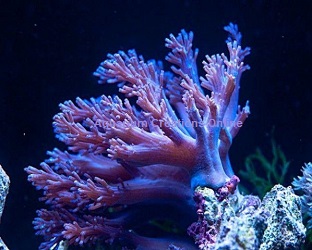Blue Cespitularia is an unusual color form for the reef tank making it one of the hobby's very sought after soft corals. The Blue Cespitularia, also referred to as Blue Xenia, has beautiful polyps dressed in a almost neon like blue coloration which will draw the attention of all your reef aquarium visitors. The Cespitularia genus of corals falls under the family Xeniidae and is closely related to Xenia and Anthelia. Delicate, feathery polyps grow on the ends of long stalks, but Cespitularia sp. lack the rapid pulsing behavior found in many other Xeniids. Cespitularia species are located throughout Indo-Pacific Area and Red Sea. Colonies are usually found in shallow areas near the shoreline in both clear and turbid water that is somewhat protected from heavy wave action. Cespitularia reproduce asexually like other Xeniids through colonial fission. Aquaculture Blue Cespitularia is a great candidate to be the center piece of any aquarium because it is both rare and beautiful! It is a "must have" for the serious soft coral collector
Aquacultered
We aquaculture our own Blue Cespitularia Xenia here at Aquarium Creations, by cutting off fragments of our mother colonies. The Blue Cespitularia Xenia we ship you is many generations aquacultured. This is very important since aquacultured Xenia are hardier than wild-collected specimens and are without the potential to carry sea born infections, or disease to your tank. They have lived there entire life under aquarium lighting and with aquarium type water flow and movement. A fast growing coral, provide adequate space between them and other types of soft corals.
Care Level
Moderate
Fragging
Always wait at least 30 days prior to fragging any new corals, giving plenty of time to become very stable in your reef aquarium. To frag, use a brand new razor blade. Find a section that can easily be cut and removed from the existing coral. When placing your cut fragment back into the reef aquarium you can more or less put it where you want it in the aquarium in a crevice and it will usually adhere to the rock in less than an hour. Be aware to choose a location with not to much flow in that spot so it will stay put until it adheres. Occasionally Xenia will release and float around until it finds a home it prefers but this is rare. Usually that only happens when initially placing it. After a few days as long as the Xenia is securely attached to a piece of rock you can move the new Xenia to another location in the tank. We always suggest not moving a new Xenia out of its original aquarium for at least 30 days. This allows the new colony to become strong and healthy.
Aggressiveness
Peaceful
Lighting & Flow Requirements
Cespitularia Xenia requires a moderate level of water flow and a low to moderate level of lighting. Lighting can be Power compacts, T5's, LED's or even Metal Halides. All lighting can grow Xenia Corals as long as the proper level of light is provided. If a Par meter is available the appropriate lighting level is anywhere from a Par 80 all the way to a Par 250. Which is a wide range of acceptability. For lighting spectrum use between a 14-20K color spectrum for your bulbs for best coloration.
Placement
Placement can be any where in the aquarium as long as it receives adequate water flow and lighting levels. Also be certain to leave enough room around your corals that they have room for growth without infringing on another corals growing room or lighting.
Diet and Feeding
Xenia corals receive the majority of their nutritional requirements through the process of photosynthesis, which simply means their lighting creates symbiotic algae called zooxanthellae in the body of the leather coral which provides its nutrition. We do recommend providing supplemental food such as micro-plankton or foods designed for filter-feeding invertebrates.
|



